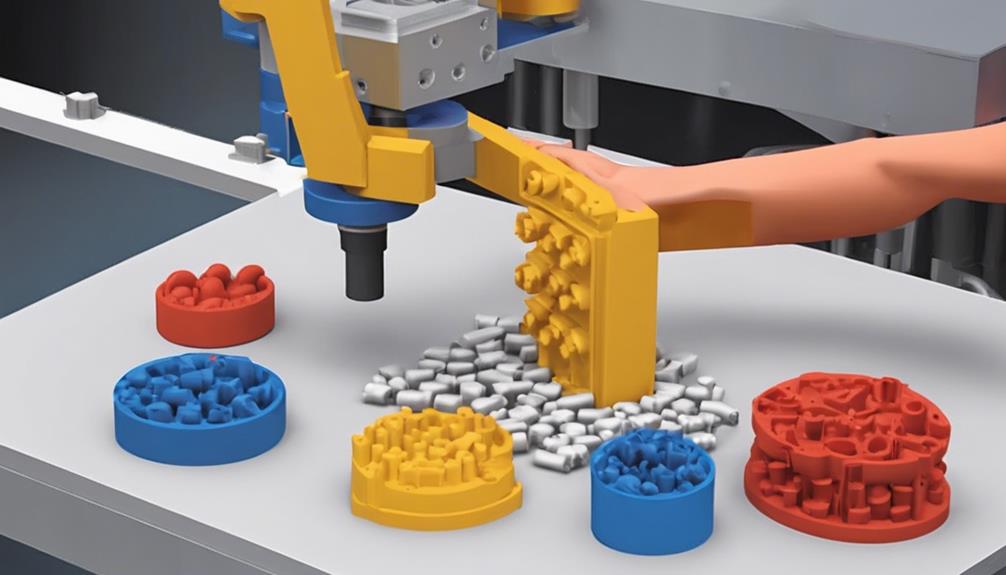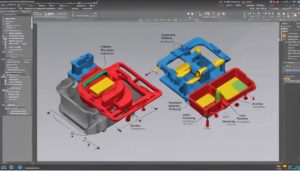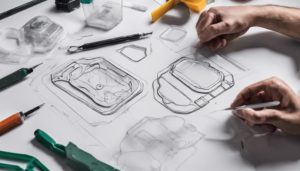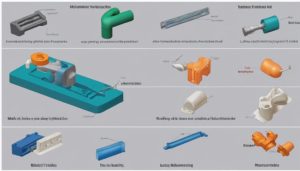Injection molded plastic is meticulously crafted by melting plastic pellets precisely and injecting them into specialized molds. This controlled process guarantees the production of high-quality, intricate components for various industries. The thermoplastic pellets are heated in a barrel to a fluid state and then injected into the mold cavity under high pressure. The cooling and solidification stages are crucial for shaping the final product. With advanced technologies and precise control, injection molding offers efficient mass production of complex designs with high precision. If you seek to understand the intricate details further, continue exploring the molding process's intricacies.
Injection Molded Plastic Overview
Injection molded plastic production involves the precise melting of plastic pellets, injection into a mold cavity, and subsequent cooling to achieve the desired final product. The molten plastic flows into the mold cavity, which is formed by two halves that are brought together during the process. These mold halves are typically created using CNC machining to guarantee accuracy and consistency in the final product.
During the injection molding process, the molten plastic is under high pressure, allowing it to fill the mold completely and take its final shape. Once the plastic has cooled and solidified within the mold, the two halves are separated, revealing the newly formed injection molded parts.
This method is highly efficient for mass production of intricate and uniform components like consumer electronics cases and disposable cutlery. The precision offered by CNC machining in creating the mold halves ensures that each injection molded part meets the required specifications consistently.
Plastic Pellet Melting Process
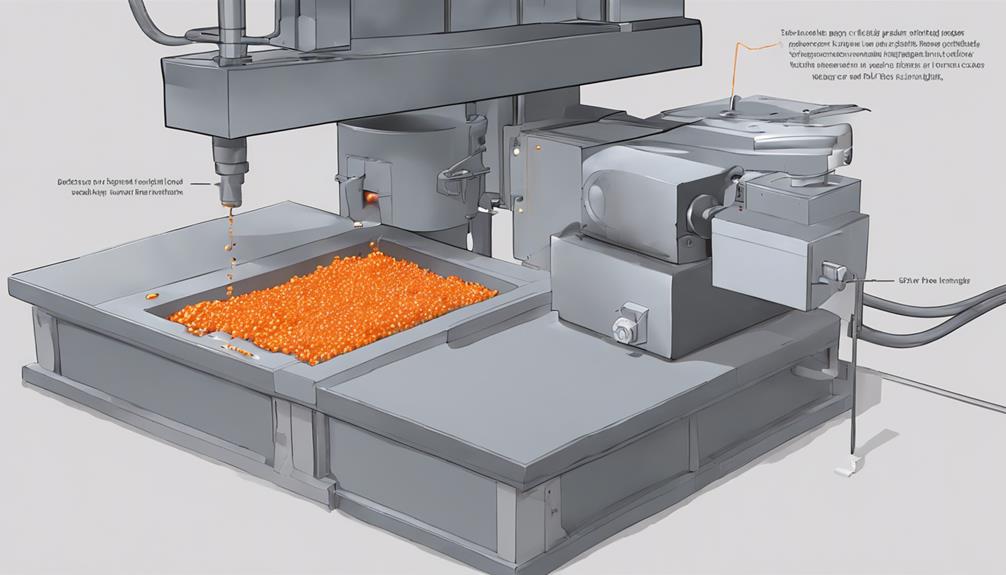
Plastic pellet melting is a critical stage in the injection molding process. Here, the thermoplastic pellets are gradually heated in the barrel by the injection screw to form a molten plastic substance. This stage is crucial as it guarantees the plastic material is in a fluid state, ready for injection into the mold cavity for shaping.
Precise temperature control within the barrel is essential to achieve the desired consistency and flow of the molten plastic during the injection process.
Pellet Heating Stage
During the pellet heating stage of the injection molding process, plastic pellets are introduced into the hopper situated atop the molding machine. The plastic pellets then enter the heated barrel, where they are gradually melted by the controlled temperature of the barrel and the frictional heat generated by the turning screw.
Maintaining a consistent temperature is vital during this stage to guarantee the plastic melts uniformly and flows correctly through the system. This careful control of temperature allows for efficient material flow and prevents issues like overheating or underheating, which could impact the quality of the final product.
Once the plastic is fully melted, it is ready to be injected into the mold cavity for shaping in the next stage.
Molten Plastic Formation
In the process of injection molding, the molten plastic formation stage, also known as the plastic pellet melting process, is a vital step where plastic pellets undergo controlled heating to achieve a fluid state suitable for molding.
Plastic pellets are fed into the machine's hopper, then gradually melted in the heated barrel through the screw mechanism. Maintaining proper temperatures is essential to efficiently melt the thermoplastic material.
Once molten, the plastic is ready for injection into the mold tool cavity. This transformation guarantees the plastic is in a molten state, enabling it to take the shape defined by the mold tool accurately.
Achieving the right consistency of molten plastic is crucial for producing high-quality injection molded products.
Injection Unit Function
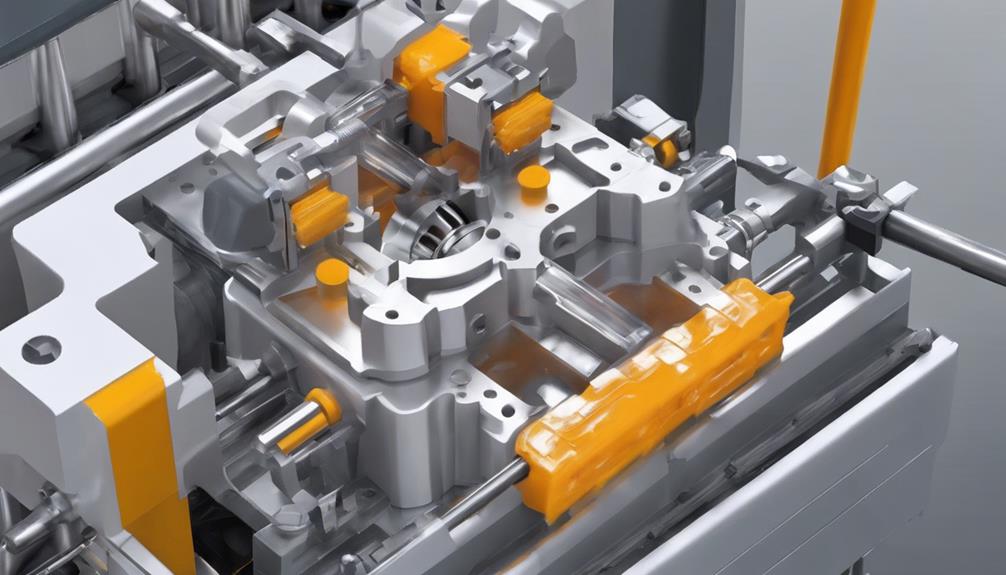
The injection unit plays a vital role in the injection molding process by melting plastic pellets and delivering the molten material into the mold cavity. It utilizes a screw mechanism to transport, melt, and inject the resin at the required temperature.
This unit's precision and efficiency in melting and injecting the plastic material are fundamental to achieving high-quality molded products.
Injection Process Basics
The injection unit within an injection molding machine plays a critical role in the production process by effectively melting plastic pellets using a reciprocating screw mechanism. This unit's primary function is to transport, mix, and melt raw plastic uniformly to prepare it for the injection molding process. The reciprocating screw, aided by heater bands in the barrel, heats the plastic to a molten state for injection. By inducing shear forces, the screw efficiently melts the plastic. Additionally, the screw design prevents the backward flow of plastic during the injection process, ensuring a smooth and controlled operation.
| Injection Process Basics | |
|---|---|
| Function | Melting plastic pellets |
| Key Component | Reciprocating screw |
| Heating Mechanism | Heater bands |
| Melting Efficiency | Induced shear forces |
| Operation Control | Prevents backward flow |
Melt and Inject Resin
Within the injection unit of an injection molding machine, the essential function of melting and injecting resin is carried out with precision and control. Raw plastic resin pellets are fed into the injection unit, where a reciprocating screw conveys and mixes the resin, applying heat for melting.
Heater bands encompassing the barrel of the injection unit guarantee the resin reaches and maintains the ideal temperature for injection. Once the resin is in a molten state, it is propelled under pressure into the mold cavity to adopt the desired product's shape.
This intricate process highlights the critical role of the injection unit in orchestrating the accurate and controlled delivery of molten resin during the injection molding operation.
Mold Cavity Shaping
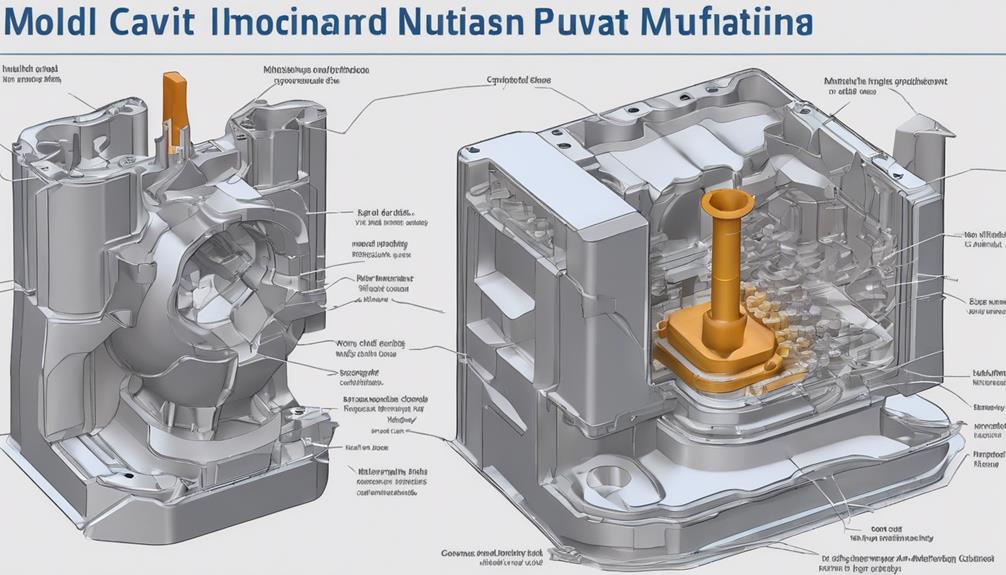
In the process of injection molded plastic fabrication, the meticulous shaping of the mold cavity plays a critical role in defining the ultimate form and quality of the end product. Mold cavity shaping involves creating the negative space in the mold where molten plastic will be injected and formed into the final product.
- Precision Machining: The mold cavity is designed with precision to guarantee accurate dimensions and surface finish of the plastic component. This precise machining is essential for achieving the desired shape and features of the final product.
- Complex Shapes and Details: Complex shapes and intricate details in the final product are achieved through precise machining and tooling of the mold cavity. The ability to accurately replicate intricate details is vital for producing high-quality injection molded parts.
- Impact on Final Aesthetics and Quality: Mold cavity shaping is crucial for determining the final aesthetics, functionality, and quality of the injection molded plastic part. The quality of the mold cavity directly affects the consistency and repeatability of the injection molding process.
Plastic Cooling and Solidification
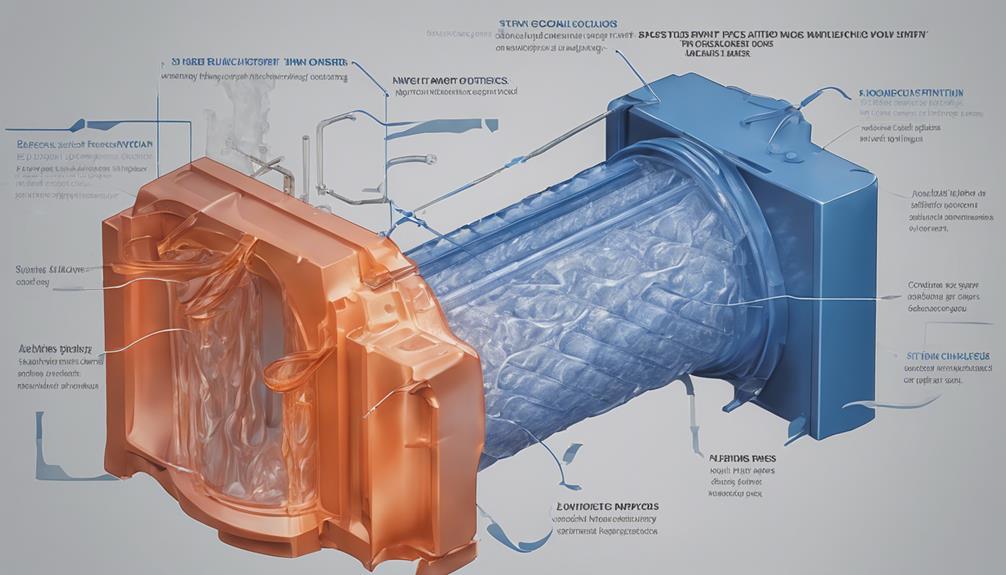
The plastic cooling and solidification stage in injection molding plays a critical role in shaping the final product.
Understanding the cooling process overview and solidification mechanisms is essential for achieving ideal part quality and performance.
The importance of uniform cooling cannot be overstated, as it directly impacts the material properties and dimensional accuracy of the molded plastic parts.
Cooling Process Overview
Efficient control of the cooling process is important in injection molding to guarantee the proper solidification of molten plastic within the mold.
Cooling Process Overview:
- Controlled Cooling: Precise regulation of cooling rates is essential to guarantee uniform solidification throughout the plastic component.
- Efficiency: Ideal cooling times must be established to balance solidification requirements with production throughput.
- Maintaining Part Quality: Proper cooling prevents defects like warping or shrinkage, ensuring the final product meets quality standards.
In injection molding, the cooling process directly impacts the quality and properties of the plastic component being produced. By carefully managing cooling rates and times, manufacturers can achieve consistent and high-quality parts while maximizing production efficiency.
Solidification Mechanisms Explained
Solidification mechanisms in injection molding intricately govern the plastic cooling and solidification process, dictating the final properties of the manufactured components.
During cooling, uniform cooling is important to guarantee consistent part quality and minimize warping or internal stresses.
Variations in cooling rates within the mold can impact the crystallinity and mechanical properties of the end plastic part significantly.
The integration of cooling channels within the mold plays an essential role in regulating the cooling process, allowing for precise control over the solidification process to achieve the desired part characteristics.
Efficient management of the cooling and solidification processes not only influences the mechanical properties of the plastic but also affects cycle times, production rates, and overall manufacturing costs in injection molding.
Importance of Uniform Cooling
During the cooling and solidification process in injection molding, guaranteeing uniform cooling of the plastic material is fundamental for maintaining part quality and minimizing potential defects.
Importance of Uniform Cooling:
- Preventing Warping: Uniform cooling helps prevent warping and internal stress in the final product.
- Consistent Part Dimensions: Proper cooling guarantees consistent part dimensions, reducing defects like sink marks or air traps.
- Enhanced Structural Integrity: Achieving uniform cooling is essential for maintaining structural integrity and surface finish quality in molded plastic components.
Cooling time is carefully calculated based on material properties and part geometry to optimize production efficiency. Advanced techniques like conformal cooling channels in molds can further enhance the cooling process for improved part outcomes.
Product Ejection Mechanism
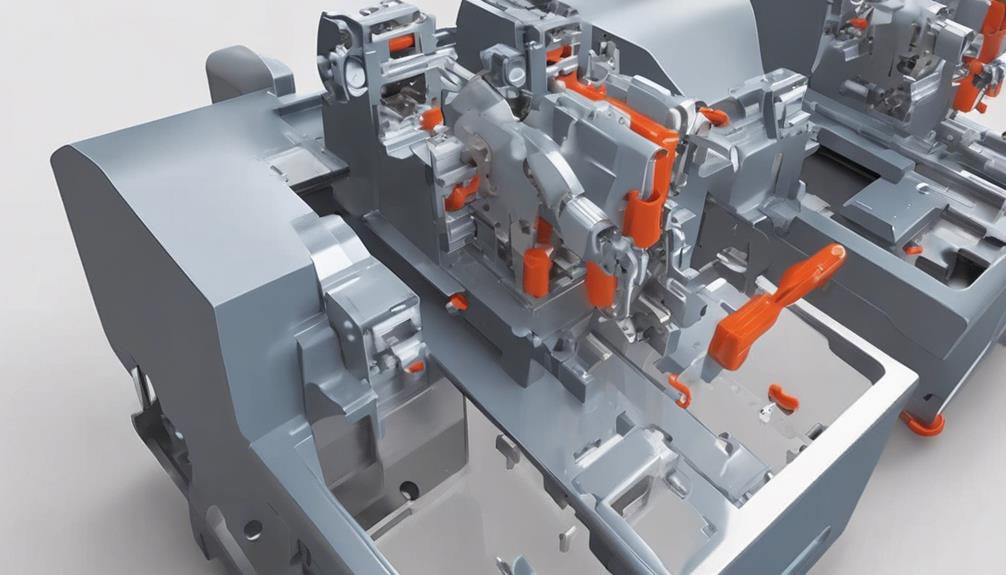
The mechanism for ejecting products in injection molded plastic involves the use of ejection pins or plates that are actuated by hydraulic or mechanical systems. These ejection pins play a critical role in pushing the molded plastic parts out of the mold cavity once the plastic has solidified. Actuated systems, whether hydraulic or mechanical, provide the necessary force and precision for the ejection process. During ejection, these pins may leave small witness marks on the final plastic components, a common occurrence in injection molding.
Efficient ejection mechanisms are crucial for the successful release of solidified plastic parts from the mold. Proper ejection ensures the smooth removal of components, allowing for further processing and finishing. The ejection system must be carefully designed and maintained to prevent any damage to the parts or the mold itself. By incorporating well-functioning ejection mechanisms, manufacturers can streamline the production process and maintain product quality.
Machine Clamp Operation
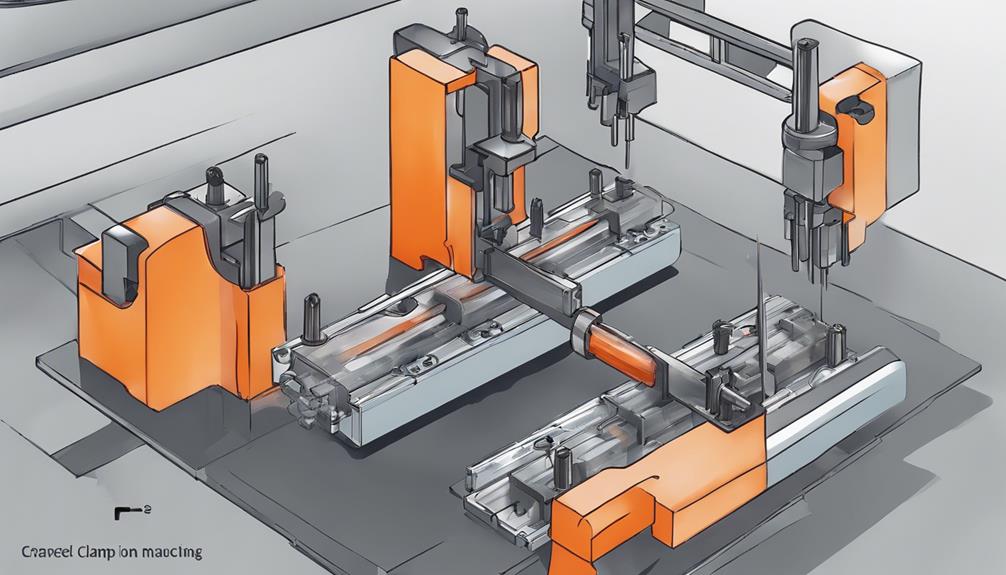
The operation of the machine clamp in injection molding is integral to securing the mold effectively during the injection process, ensuring precise and consistent molding results. To achieve this, the machine clamp utilizes hydraulic systems or mechanical systems that apply pressure to keep the mold closed.
Here are some key points to bear in mind regarding the machine clamp operation:
- Clamp Force: The clamp force is vital in injection molding as it prevents flash – excess material along the parting line – and maintains the quality of the final part. The clamp force is typically measured in tons and is determined based on the size of the part being produced and the material being used.
- Clamp Operation: Proper clamp operation is essential for successful injection molding. It involves the precise application of pressure to keep the mold securely closed during the injection and cooling processes.
- Hydraulic Systems: Many modern injection molding machines use hydraulic systems to generate the force needed for the clamp operation. These systems provide the power necessary to maintain the required clamp force throughout the molding cycle.
Mass Production Advantages
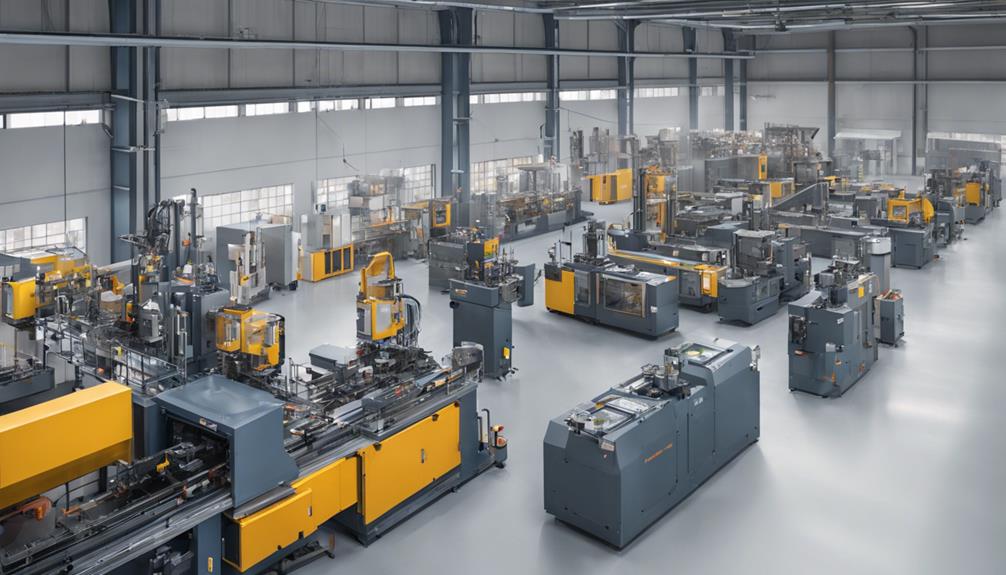
Utilizing injection molded plastic for mass production offers unparalleled advantages with regards to precision, efficiency, and cost-effectiveness.
The high precision achieved through injection molding allows for the production of identical parts consistently, meeting strict quality standards in mass production. Efficiency is a key benefit as the process enables rapid production rates, producing large quantities of components within a short timeframe.
This rapid production rate coupled with the ability to create complex designs results in cost-effective manufacturing solutions for high volume production runs. The automated nature of injection molding further enhances efficiency by reducing labor costs and increasing production output for mass-produced plastic items.
The process's ability to deliver consistent quality and repeatability makes it a preferred choice for industries requiring large quantities of plastic components with high precision and efficiency at a cost-effective manner.
Precision and Efficiency Benefits

Injection molded plastic manufacturing excels in providing unparalleled precision and efficiency benefits, making it a top choice for industries requiring consistent part production at high speeds.
The process offers tight tolerances as precise as +/- 0.005 inches, ensuring that parts are uniform and accurate. Efficiency is another key advantage, with machines capable of producing hundreds of parts per hour due to rapid production cycles.
Additionally, the method allows for the creation of complex geometries and intricate designs, enabling the production of detailed components that meet specific requirements. The excellent surface finish quality of injection molded plastic parts reduces the need for additional finishing processes, saving both time and cost.
Furthermore, the repeatability of injection molding ensures consistency in part dimensions and properties, which is vital for quality control and maintaining uniformity in mass production processes.
Popular Manufacturing Method
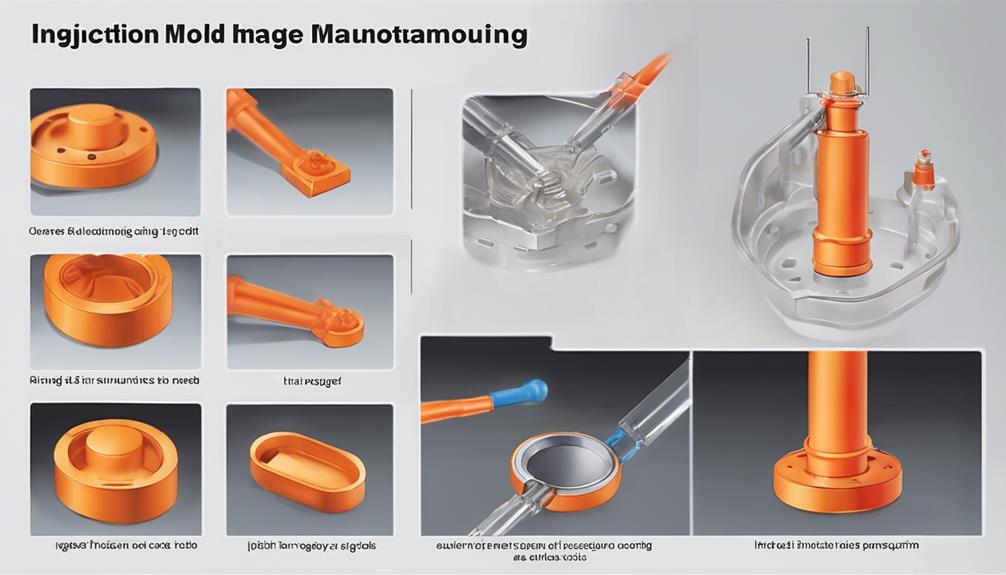
An extensively utilized method in the manufacturing industry for producing a wide range of plastic products is injection molding. This process involves the use of steel molds, typically consisting of a cavity half and a core half, that are designed to shape the molten plastic into the desired form. The injection mold incorporates a runner system, which is a network of channels that allow the molten plastic to flow from the injection unit into the mold cavity.
The cavity half of the mold is where the molten plastic is injected under high pressure, filling the empty space to form the final product shape. The runner system plays an important role in guiding the plastic flow and ensuring uniform filling of the mold cavity. Once the plastic has cooled and solidified within the mold, the clamp opens, and the ejector pins push the newly formed part out of the mold. This popular manufacturing method enables the efficient and cost-effective production of various plastic items, ranging from small components to larger and more complex products.
Wide Range of Plastic Products
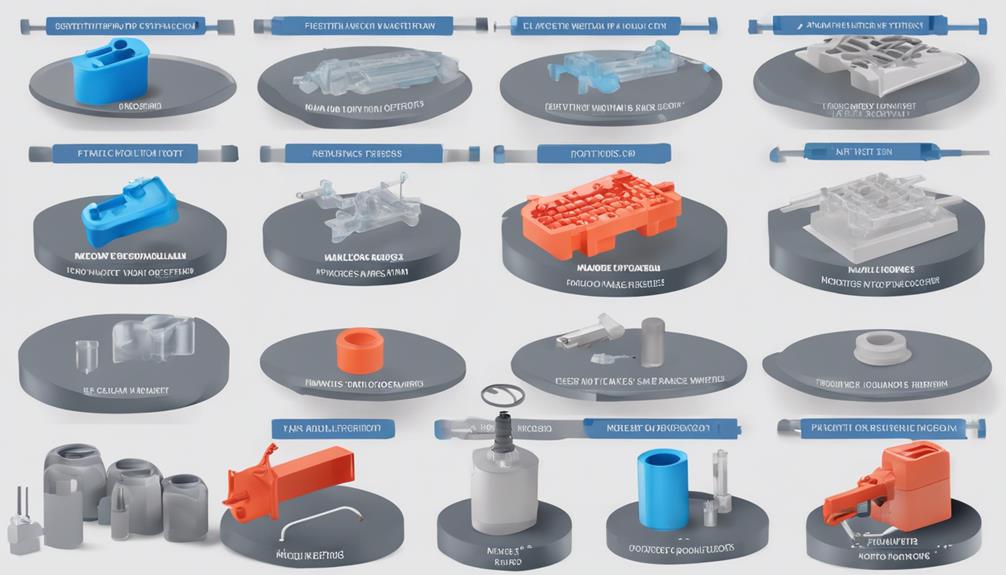
The versatility of injection molded plastic products encompasses a diverse array of applications across various industries. Plastic injection molding allows for complex manufacturing processes to create a wide range of products with high precision and consistency. Here are some key points worth noting:
- Diverse Product Range: Injection molded plastic is utilized in the manufacturing of chairs, toys, consumer electronics cases, disposable cutlery, and even iconic Lego bricks. The process parameters can be fine-tuned to meet the specific requirements of each product, ensuring uniform quality and performance.
- Material Flexibility: Various thermoplastics such as ABS, Nylons, Polycarbonate, and Polypropylene are commonly employed in plastic injection molding. This diverse selection of materials enables manufacturers to tailor the properties of the final product to suit different applications, from impact resistance to heat tolerance.
- Cost-Effective Production: Injection molding enables cost-effective mass production of plastic components by minimizing material waste and reducing the need for extensive manual labor. This efficient production method helps in keeping the cost of production low, making it a preferred choice in industries where high volumes of consistent quality products are required.
High Precision Output
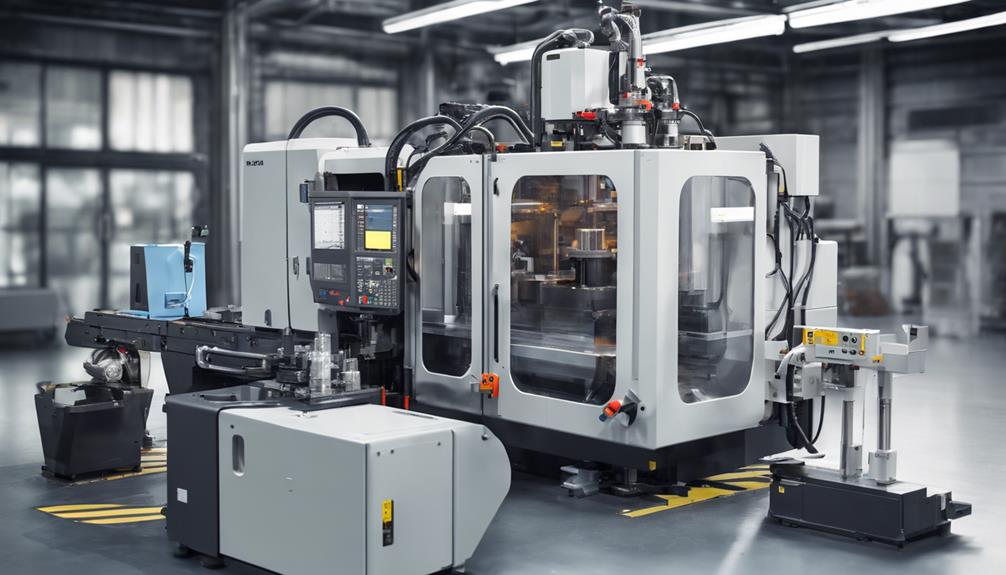
Achieving exceptional precision in the output of injection molded plastic components relies heavily on the meticulous control and optimization of critical process parameters. Key factors contributing to high precision output include maintaining precise temperature control throughout the injection molding process.
Controlling the pressure exerted during the injection phase is vital for guaranteeing accurate replication of intricate details in the final plastic components. Additionally, optimizing cooling times is essential to prevent warping or deformities in the molded parts, thereby enhancing overall precision.
Advanced mold design and tooling technologies play a significant role in achieving high precision output by facilitating consistent and accurate replication of complex geometries. Injection molding machines equipped with precise control systems and high-quality molds help in achieving tight tolerances required for producing intricate plastic components.
The selection of high-quality thermoplastics and specialized materials further contributes to the production of precise plastic parts with minimal defects. Implementing quality assurance measures, such as inspection and testing protocols, safeguards the accuracy and precision of the injection molded plastic components.
Efficiency in Manufacturing Industry
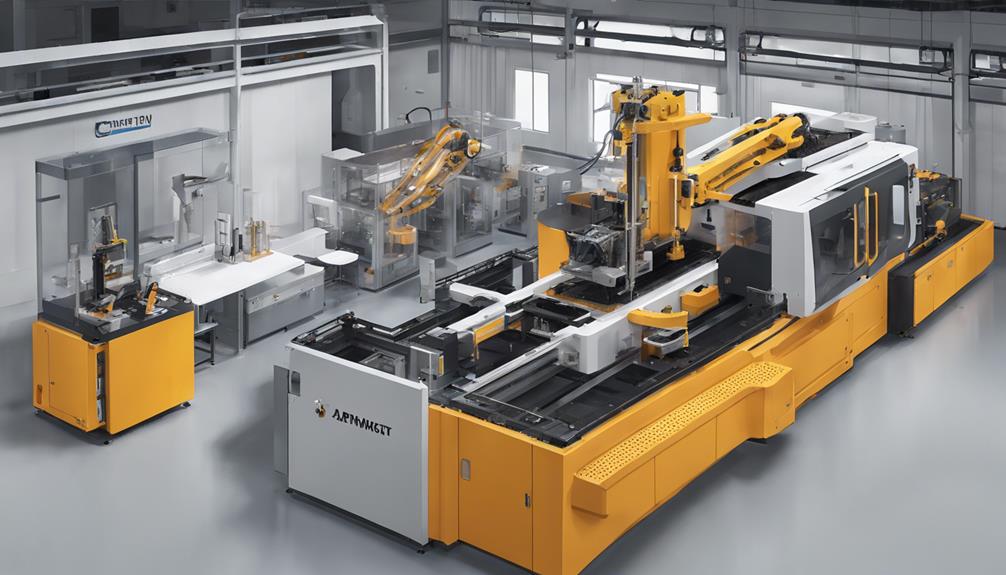
Exemplifying streamlined production processes, the efficiency of injection molding in the manufacturing industry is underscored by its rapid cycle times and automated operations.
- Short Cycle Times: Injection molding can achieve remarkable efficiency with cycle times as brief as a few seconds per part, enabling the production of a high volume of components in a relatively short period.
- 24/7 Operation: Modern injection molding machines can operate continuously, 24 hours a day, 7 days a week, ensuring a constant output of components and maximizing productivity.
- Automation and Process Control: The automation integrated into injection molding processes reduces the need for human intervention, leading to decreased labor costs and increased efficiency. Additionally, tight process control mechanisms guarantee consistent quality across all produced parts while minimizing material waste.
Frequently Asked Questions
What Is the Process of Injection Molding Plastics?
The process of injection molding plastics involves melting plastic pellets, injecting the molten material into a mold cavity, and allowing it to cool and solidify under controlled conditions.
This method guarantees the production of high-quality plastic parts with precise dimensions and intricate details.
What Material Is Used for Injection Molding Plastic?
Injection molding plastics commonly utilize materials like ABS, Nylons, Polycarbonate, and Polypropylene. These materials each offer unique properties suitable for diverse applications.
For instance, ABS is esteemed for its impact resistance, while Nylons provide strength and chemical resistance.
Polycarbonate's transparency and heat resistance make it ideal for optical components, and Polypropylene's chemical resistance and affordability are favored in packaging and automotive sectors.
Each material contributes distinct advantages to the injection molding process.
How Does Plastic Get Molded?
Plastic is molded by a process called injection molding, where molten plastic is injected into a mold cavity at high pressure. The plastic then cools and solidifies in the mold to take the desired shape.
Injection molding machines are equipped with precise control systems for accuracy. The mold design includes features like gates, runners, and ejector pins to facilitate efficient production.
Ejection systems are used to remove the molded parts from the mold for further processing and packaging.
How Are Injection Mould Tools Made?
Injection mold tools are meticulously crafted using advanced manufacturing techniques. Materials like steel, aluminum, and beryllium-copper alloy are employed based on volume requirements and heat dissipation needs.
Steel molds offer exceptional durability for high-volume production, while aluminum molds are a cost-effective solution for lower quantities. Beryllium-copper inserts aid in efficient heat removal during the molding process, ensuring superior part quality.
Precision machining and EDM are integral in creating intricate mold designs.
Conclusion
To sum up, the process of creating injection molded plastic involves intricate steps such as:
- Plastic pellet melting
- Injection unit function
- Mold cavity shaping
- Plastic cooling
This manufacturing method is popular for its efficiency and ability to produce a wide range of high precision plastic products. Despite its complexity, injection molding is a straightforward and simple process that has revolutionized the manufacturing industry.
